|
|
Looping with the
Lexicon JamMan and Cakewalk
by Reginald Hunt
January 3, 1998

The Lexicon JamMan
is an audio device designed to provide for certain types of echo and looping functions. It allows for setting the loop/echo time by either front panel switch, footswitch, MIDI Patch Change, or MIDI clock.
Three basic modes can be used:
- Echo. Delay that repeats continuously and fades out according to the FEEDBACK setting.
- Punch in Loop. Delay that repeats continuously. When TAP is pressed, audio can be recorded into the loop, then pressing TAP again prevents further recording until TAP is pressed again. The audio can also be replaced or muted depending on the SELECT setting. Multiple loops can be recorded and played back in any order.
- Phrase Loop. Same as Punch In except certain functions won't take effect until the loop start is encountered.
Cakewalk
is a software package that provides a wide range of MIDI and Audio recording functions. It is particularly useful for having MIDI and Audio tracks all in one song file, and allows for extensive editing any track while keeping them all in sync.
This page provides an example of syncing the JamMan to Cakewalk using the Punch In Loop mode. It does not cover the Replace or Mulitple Loop functions, or the Echo mode. It also shows how well looping and digital editing can work together.
Here I provide a somewhat step-by-step overview of creating a piece using MIDI tracks and JamMan loops using screen captures from Cakewalk¨ and RealAudio files to illustrate the results.
Drum Track
For this example, I elected to start with a MIDI drum track. It is displayed in Cakewalk¨ as rectangles representing "clips", which can be dragged, cut, pasted, copied, etc. This drum track is actually just a 1 measure phrase, copied 4 times to start.
|

Bass Track
I then recorded a MIDI bass part, which is only 2 beats long. Then I copied it once.
|
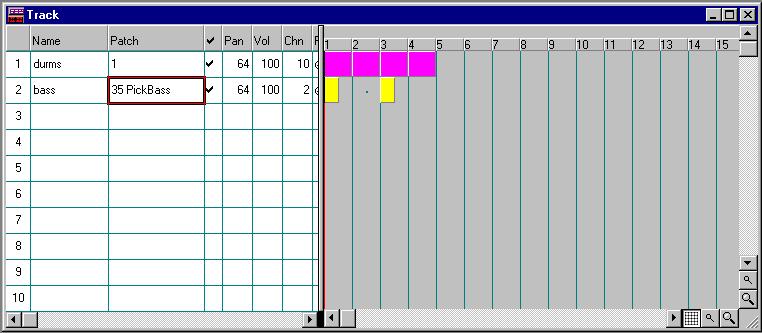
| I then pasted enough copies of this phrase to fill two and a half minutes.
JamMan Commands
It was then time to create an event list that contained the MIDI Patch Change commands to control the JamMan. In the Punch In Loop mode, the commands used are:
Program Change 2.....RESET....Clears the loop memory, and sets the delay time to minimum.
Program Change 1....TAP.....Sets the delay time. There seems to be 2 ways to use this. If the sequencer is sending out MIDI clock, the TAP function should be used to set the beginning and ending of the quarter note length. This way, if the Punch In Loop is set to "8", for example, the delay time will be eight times the time between TAPs. I find this tends to give "glitchy" loops. In my case, I turn off the MIDI clock, and use the TAP to set the beginning and end of the entire delay time. This is basically freewheeling, but for shorter loops, it works well.
So, I insert a Patch Change #2 to RESET the JamMan at Measure 2. Then, to get a two measure delay time, I send a Patch Change #1 to indicate TAPs at Measure 3 to start the delay setting, at Measure 5 to end the delay setting, and at Measure 6 to have the JamMan start recording audio into the loop. I also include another RESET at Measure 66, which is after the sequence ends.

First Guitar Loop
Time to record the first JamMan loop. This is done by placing Cakewalk into record, which then sets up the JamMan. When the JamMan is ready, I start playing guitar and developing the desired loop. The resulting track, of course, had a long silence because of the wait for the JamMan to set up. Cakewalk is great for editing the audio, and keeping it in step with the MIDI tracks. In this case, I cut out the initial silence and dragged the audio so that it started near the beginning of the piece. I was also able to "normalize" the audio to maximize its volume level without distorting.
|

| This audio track did not extend the entire length of the piece, so I made a copy of the last 2 measures of the audio and copied it multiple times, thus extending the loop without eating more disk space than necessary. Shown here is the clip that needed to have the start and end faded to allow a seamless joining of the clips. |
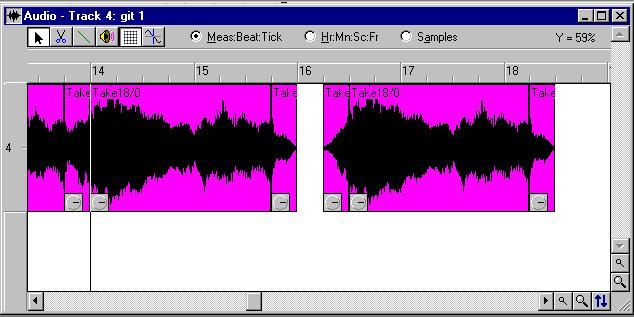
"Stereo-ize" the Loop
Cakewalk offers flexibilty in editing that's hard to resist. In this case, I took the loop clip I had already made, copied onto a new track, "reversed" it so that it plays backwards, and panned the the two tracks to extreme Left & Right. Then I pasted the new clip enough times to extend it ot the end of the piece. Below is a picture of the 2 tracks with one reversed clip in the second track (Track 5).
|
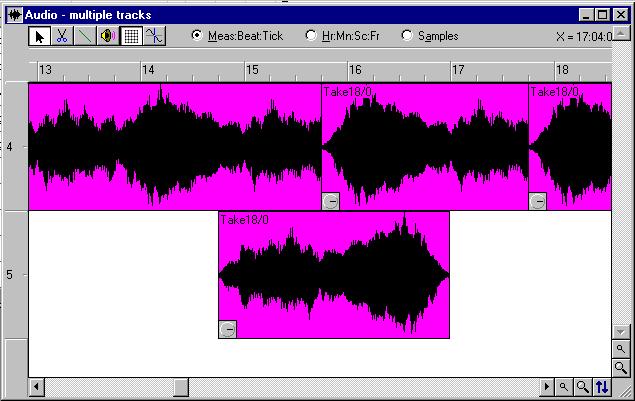
Second Guitar Loop
The Second Loop was recorded just like the first. The MIDI commands were still in place, so it was just a matter of setting up a new track for recording. After recording, I put a copy of the clip after the original, reversed it, then butted the two together. This way, the loop builds up, reverses, and thins back down. I then copied the track(Track 6)to a new track(Track 7), panned them extreme Left & Right, and "slid" the copy a half a beat to "echo"' the original.
In the graphic below, the First Loop is Blue, its reversed copy is Forest Green, The Second loop is Navy Blue, and it's copy is Azure.
|
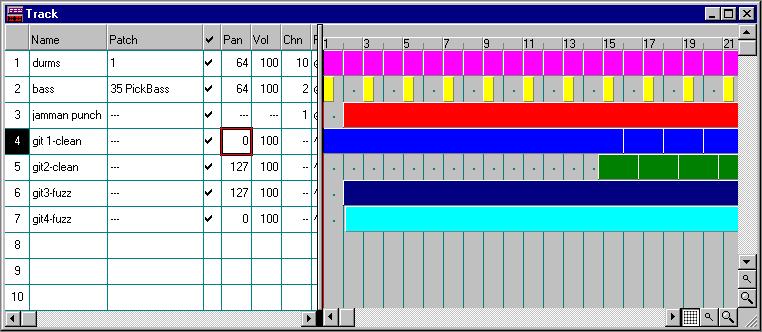
Fading in the First Reversed Loop, then Fading it out.
It seemed like the First Loop's copy came in too quick so I had the first clip of the track fade in. I also faded out the last clips in both tracks. The Second Loop just "fizzled" out since it was reversing back to its beginning.
|
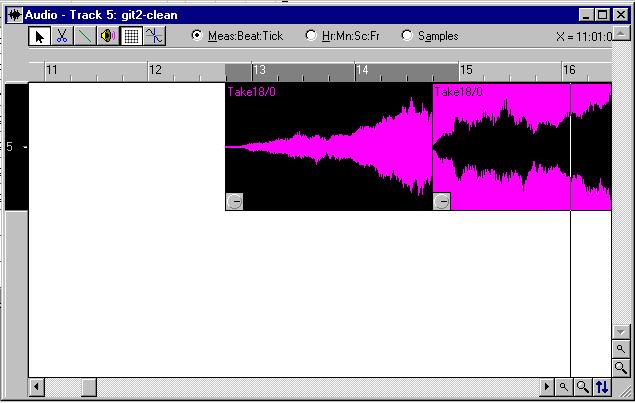
Final Mix
Here is the final result. The nice thing about this technique is that more tweaking is possible. I can polish up the drumming, add percussion maybe, add other instruments or maybe even more loops (even loops from other files), clean up some glitches, even stick in a solo.
If you have any questions, comments, or spelling corrections, please drop me a line at rphunt@tiac.net.
Check out my web site at http://www.rphunt.com
|
|
|







